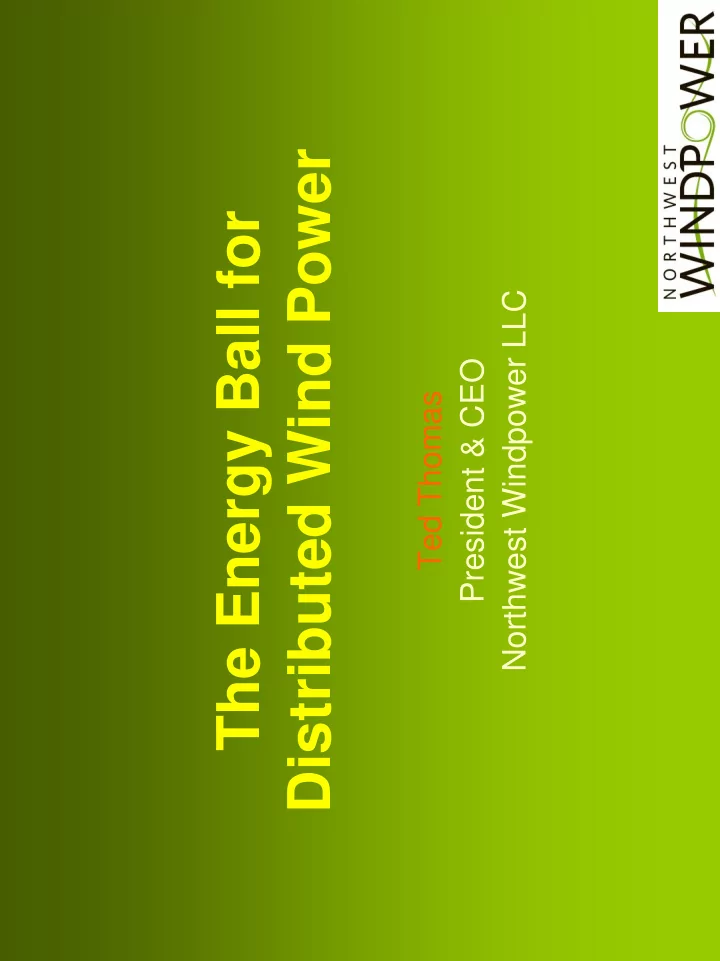

Distributed Wind Power The Energy Ball for Northwest Windpower LLC President & CEO Ted Thomas
Evolution of Wind Turbine Technology
Multiple Applications •Freeway light poles •Freeway light poles •Schools •Schools •Roof tops – commercial & residential •Roof tops – commercial & residential •Farms – agricultural - water pumps •Farms – agricultural - water pumps •Restaurants and retail stores •Restaurants and retail stores •Recreational •Recreational •Off grid – battery backups •Off grid – battery backups •Government and municipal •Government and municipal •Hybrid/electric vehicle charging •Hybrid/electric vehicle charging
Why The Energy Ball Small dimensions, decorative design • Turbine is omni directional, spins no matter what direction the wind is coming from. • Virtually Maintenance free, No continued operating costs • Low startup speed • No vibration • Noise does not exceed background noise
Energy Ball dimensions 1.55 m 1.10 m 1.85 m 66 lbs
Installation of the Energy Ball • On a mast – Lengths available: 25’, 30’, 40’ or higher depending upon local code • Flat Roof Mount • Multiple Units clustered, roof top or pole mount • Façade Mount (side of building) 6
The Energy Ball in operation Drop in pressure • Venturi principle app. 1.5 * D app. 0.8 * D The Energy Ball yaws itself in the wind 7
Annual output Energy Ball V100 V200 Av. Windspeed Annual Av. Windspeed Annual at location output at location output 18 mph 1314 kWh 18 mph 4380 kWh 15 mph 986 kWh 15 mph 3285 kWh 13.5 mph 548 kWh 13.5 mph 2190 kWh 11 mph 308 kWh 11 mph 1520 kWh • Average wind speeds above were calculated using weighted averages for both turbines over time, at 33’ above ground level.
Benefits of Wind Power • Wind is free, clean, abundant and renewable. • Cost effective for off grid, better alternative to running power lines several miles • Back up power, much quieter than running a loud generator • In direct balance/opposite of Solar Power – Wind & Solar have peak operating times that are opposite of each other. • Increase local and regional economic growth, green job’s. • Reduce Peak demand from grid • Requires less footprint • Reduces CO2 and SO2
Growth Potential & Projections • Small Wind for Residential is projected to grow by 30-fold, according to AWEA. BUILDING-MOUNTED TURBINES less than 0.002% of the US small-wind market Was from Building mounted Small Wind Turbines. • Driving forces affecting growth in Residential ; manufacturing, rising electricity prices and heightened public Awareness. (Seattle City Light has Projected 23% increase over the next three years). • EV (Electric Vehicle) Charging Stations
Seattle CODE ISSUES • Current Restrictions inhibiting small wind turbines in Residential areas: • Where we need to be: Standard model ordinance allowing turbines in all residential areas Pass an ordinance that puts wind on equal footing as Solar, (i.e., HOA’s)
Permitting Zoning/permitting. Poor or absent local permitting practices thwart an Estimated 1/3 ore more of all potential small wind turbine installations. Unnecessary & restrictive regulations, can limit a turbine’s productivity, Discourage customers and investment, and repel local industry-related businesses from communities. Example: Flagpoles, lamp posts, and utility poles are allowed in front of schools and parking lots because they are engineered structures, just like wind turbine towers. They should all receive the Same equal treatment under law. • The Seattle Building Code for Residential zones do not currently include a specific section on wind turbines, as it does for solar power.
Progress in Seattle • The Seattle City Council has just passed a new ordinance to allow small wind turbines, meeting certain criteria to be placed on multi family buildings exceeding existing height limits as of December 2009.
Wind Power Environmental Benefits • One block of wind power cuts CO2 emissions by 2,988 pounds each year. • One block of wind power achieves 3.5 times the reduction achieved by recycling. • Wind + Solar + Recycling = Smaller Foot Print
www.northwestwindpower.net Thank you for more information . Visit
Recommend
More recommend